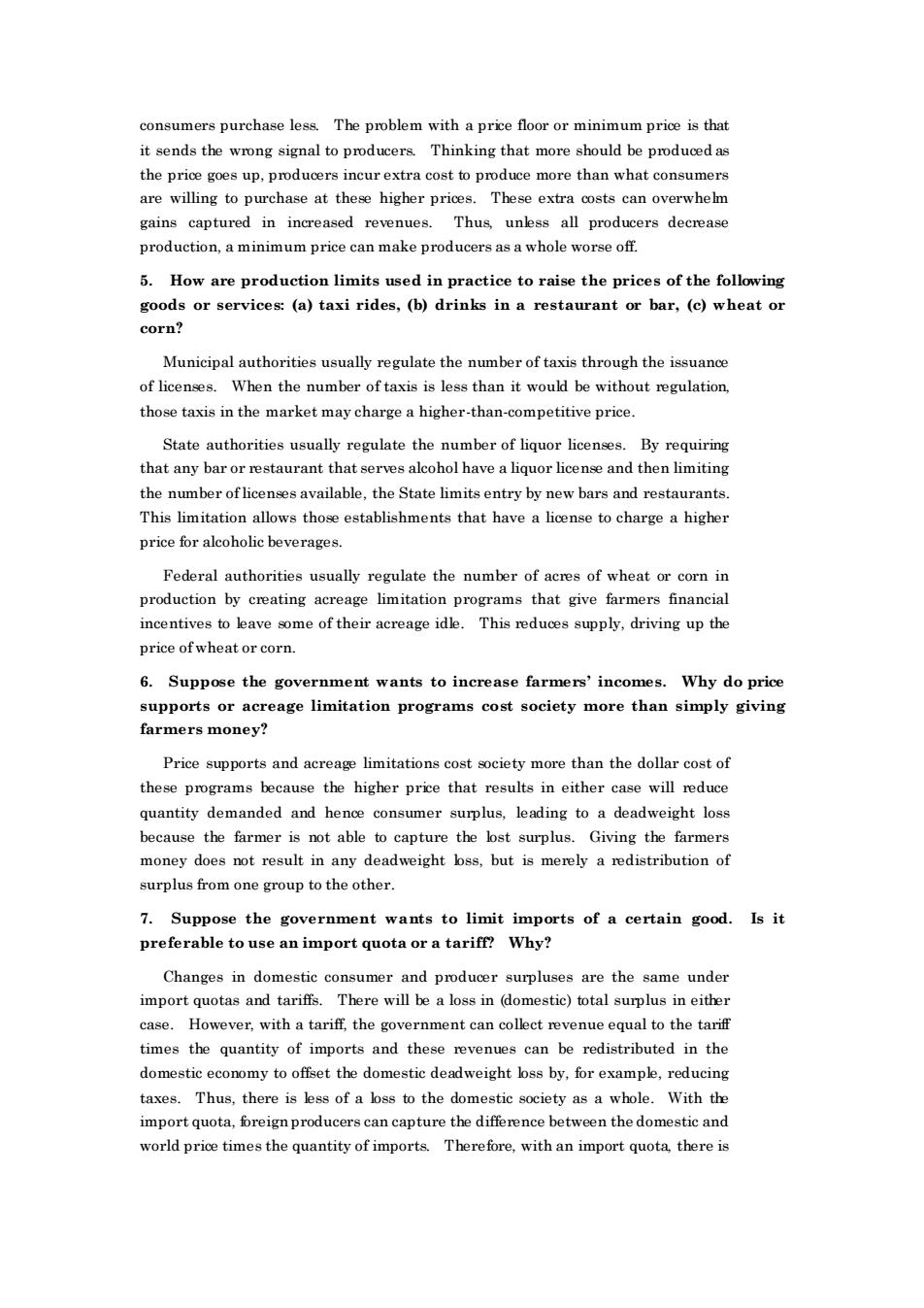正在加载图片...

consumers purchase less.The problem with a price floor or minimum price is that the price goes up,producers incur extra cost to produce more than what consumers are willing to purchase at these higher prices.These extra costs can overwhelm gains captured in increased revenues.Thus unless all producers decrease production,a minimum price can make producers as a whole worse off 5.How are production limits used in practice to raise the prices of the following goods r services (a)taxi rides (b)drink o bar,(c)wheat or corn? Municipal authorities usually regulate the number of taxis through the issuance of licenses.When the number of taxis is less than it would be without regulation. those taxis in the market may charge a higher-than-competitive price. State authorities usually regulate the number of liquor licenses.By requiring that any bar or restaurant that serves alcohol have a liquor license and then limiting the number oflicenes available,the State limits entry by new bars and restaurant This limitation allows those establishments that have a license to charge a highe price for alcoholic beverages. Federal authorities usually regulate the number of acres of wheat or corn in production by creating acreage limitation programs that give farmers financial incentives to leave some of their acreage idle.This reduces supply,driving up the price of wheat or corn. 6.Suppose the gove ent wants to increase farmers'incomes.Why do price supports or acreage limitation programs cost society more than simply giving farmers money? Price supports and acreage limitations cost society more than the dollar cost of these programs because the higher price that results in either case will reduce quantity demanded and hence consumer sumplus.leading to a deadweight loss because the farmer is not able toc apt ure the lost s urplus. Giving the farmers money does not result in any deadweight bss but is merelya redistribution of surplus from one group to the other. 7.Suppose the government wants to limit imports of a certain good.Is it preferable to use an import quota or a tariff?Why? Changes in domestic consumer and producer surpluses are the same under import quotas and tariffs.There will be a loss in (domestic)total surplus in either ease.However,with a tariff,the go ernment can colkct revenue equal to the tarif the quantity of imports and these revenue can be domestic economy to offset the domestic deadweight lss by,for example,reducing taxes.Thus,there is less of a loss to the domestic society as a whole.With the import quota,foreign producers can capture the difference between the domestic and world price times the quantity of imports.Therefore,with an import quota there isconsumers purchase less. The problem with a price floor or minimum price is that it sends the wrong signal to producers. Thinking that more should be produced as the price goes up, producers incur extra cost to produce more than what consumers are willing to purchase at these higher prices. These extra costs can overwhelm gains captured in increased revenues. Thus, unless all producers decrease production, a minimum price can make producers as a whole worse off. 5. How are production limits used in practice to raise the prices of the following goods or services: (a) taxi rides, (b) drinks in a restaurant or bar, (c) wheat or corn? Municipal authorities usually regulate the number of taxis through the issuance of licenses. When the number of taxis is less than it would be without regulation, those taxis in the market may charge a higher-than-competitive price. State authorities usually regulate the number of liquor licenses. By requiring that any bar or restaurant that serves alcohol have a liquor license and then limiting the number of licenses available, the State limits entry by new bars and restaurants. This limitation allows those establishments that have a license to charge a higher price for alcoholic beverages. Federal authorities usually regulate the number of acres of wheat or corn in production by creating acreage limitation programs that give farmers financial incentives to leave some of their acreage idle. This reduces supply, driving up the price of wheat or corn. 6. Suppose the government wants to increase farmers’ incomes. Why do price supports or acreage limitation programs cost society more than simply giving farmers money? Price supports and acreage limitations cost society more than the dollar cost of these programs because the higher price that results in either case will reduce quantity demanded and hence consumer surplus, leading to a deadweight loss because the farmer is not able to capture the lost surplus. Giving the farmers money does not result in any deadweight loss, but is merely a redistribution of surplus from one group to the other. 7. Suppose the government wants to limit imports of a certain good. Is it preferable to use an import quota or a tariff? Why? Changes in domestic consumer and producer surpluses are the same under import quotas and tariffs. There will be a loss in (domestic) total surplus in either case. However, with a tariff, the government can collect revenue equal to the tariff times the quantity of imports and these revenues can be redistributed in the domestic economy to offset the domestic deadweight loss by, for example, reducing taxes. Thus, there is less of a loss to the domestic society as a whole. With the import quota, foreign producers can capture the difference between the domestic and world price times the quantity of imports. Therefore, with an import quota, there is